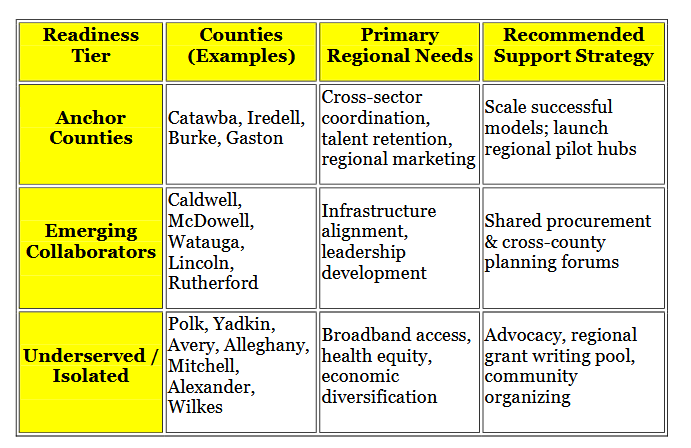Part V - Scaling and Strategy - Chapter 18: The 20-County Challenge
Part V
Scaling and Strategy
From Bright Spots to Blueprints
The Foothills Corridor has proven it’s not done. We've seen the collapse, we've tracked the early signals, and we’ve documented the foundations that are starting to hold. But now comes the real test: Can the region move from isolated progress to coordinated momentum?
This section isn’t about more ideas—it’s about building systems. Systems that scale what’s working. Systems that link counties, institutions, and communities. Systems that protect the gains already made and turn early wins into long-term wins.
Scaling isn’t just expansion. It’s refinement, adaptation, and intentional design. Strategy is not just planning. It’s making hard choices, saying no to what distracts, and aligning energy around what delivers.
If the first half of this book was about seeing clearly, this half is about building deliberately. Because the Foothills doesn't need a savior. It needs a strategy. And this chapter is where that work begins.
Chapter 18
The 20-County Challenge
The Foothills Corridor spans a 20-county region that defies easy categorization. From the foothills of the Blue Ridge to the industrial edges of I-85, it includes urban nodes, rural valleys, legacy mill towns, and fast-growing bedroom communities. This diversity is both a strength and a challenge—especially when it comes to designing scalable, region-wide strategies for revival.
The core issue is simple: How do you move together when you’ve always moved alone?
The Fragmentation Problem
For decades, each county—and often each town—has operated on its own timeline, its own politics, its own priorities. The result is a region filled with:
· Duplicated efforts in workforce training and business recruitment.
· Competing marketing campaigns.
· Inconsistent infrastructure investments.
· Uneven access to state and federal resources.
This fragmentation has led to missed opportunities, wasted dollars, and a region that underperforms its potential.
The Case for Regional Cohesion
Revival in the Foothills won’t succeed county by county—it has to be corridor-wide. The assets are distributed, the markets are regional, and the problems—labor shortages, broadband gaps, healthcare access, youth flight—don’t stop at the county line.
What’s needed is a framework that respects local control but enables shared infrastructure, shared strategy, and shared wins.
Examples of What’s Possible
Some early indicators show how this can work:
· Broadband expansion planning across multiple counties.
· The Wilderness Gateway Trail crossing county lines to link tourism and recreation assets.
· Regional healthcare coalitions addressing behavioral health with pooled resources.
· Community colleges aligning on curriculum to reduce duplication and serve more students.
These are signals of what’s possible when competition is replaced with collaboration.
What’s Blocking Progress?
There are several structural and cultural barriers:
· Governance silos: Most planning bodies have narrow jurisdiction and short-term mandates.
· Funding restrictions: Grants are often written to favor single-county administration.
· Mistrust: Historical rivalries and political differences can derail even promising partnerships.
· Capacity gaps: Smaller counties often lack the staffing to engage in broader initiatives.
Solving the 20-county challenge requires both structural fixes and cultural shifts.
What’s Needed Now
1. Regional Tables That Matter: Create decision-making bodies with real teeth—cross-county consortiums for housing, workforce, and broadband.
2. Shared Metrics and Dashboards: Track job creation, youth retention, housing starts, and access to care across all 20 counties. What gets measured gets prioritized.
3. Backbone Institutions: Identify neutral entities (like CVCC or a regional nonprofit) to facilitate strategy across boundaries.
4. Incentives for Collaboration: Design grants and state-level programs that reward joint applications and regional scale.
5. Narrative Unity: Create a brand identity that spans the Corridor—one that tells a shared story of grit, growth, and grounded innovation.
Why It Matters
If the Foothills Corridor remains a patchwork of isolated efforts, it will remain easy to overlook. But if it moves in coordinated rhythm, it becomes a force—economically, culturally, and politically.
The 20-county challenge isn’t just a logistical problem. It’s a cultural frontier. It’s where local pride either becomes parochialism—or evolves into shared purpose.
And if this region can crack that code, it won’t just revive. It will lead. Not because it became one thing—but because it learned to move as many, together.
Overcoming Barriers: What’s Blocking Progress Isn’t the Idea—It’s the Infrastructure
Regional collaboration always sounds good—until you try to do it. The barriers aren’t theoretical. They’re real, they’re old, and they’re political. Counties don’t trust each other. Leaders protect turf. Grant writers are scarce. And most importantly, no one has time to chase a vision that doesn’t come with money attached.
But the solution isn’t more strategy meetings. It’s removing friction.
What stands in the way of meaningful regional action?
Mistrust: Too many leaders still see neighbors as competitors, not allies.
Bandwidth: Even counties that want to cooperate often lack the staff to coordinate anything beyond survival.
Asymmetry: Some counties are big and well-resourced. Others are scraping by. That imbalance creates resentment before a single plan hits paper.
No Backbone: There's no neutral entity managing regional momentum. Without a "backbone institution," things stall by default.
None of this means collaboration is impossible. But it means the lift is heavier than a task force and a slogan. The groundwork must come first: relationship-building, shared language, and a low-stakes win to prove trust is possible.
This chapter lays out the vision. But the work begins when people stop asking "what’s in it for us?" and start asking, "what happens if we go it alone again?"


